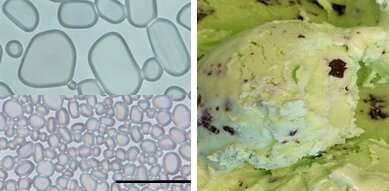Giving the cold shoulder to crunchy ice cream—with a dash of celluloseIce cream can be a culin
Giving the cold shoulder to crunchy ice cream—with a dash of celluloseIce cream can be a culinary delight, except when it gets unpleasantly crunchy because ice crystals have grown in it. Today, scientists report that a form of cellulose obtained from plants can be added to the tasty treat to stop crystals cold—and the additive works better than currently used ice growth inhibitors in the face of temperature fluctuations. The findings could be extended to the preservation of other frozen foods and perhaps donated organs and tissues.The researchers will present their results today at the spring meeting of the American Chemical Society (ACS).Freshly made ice cream contains tiny ice crystals. But during storage and transport, the ice melts and regrows. During this recrystallization process, smaller crystals melt, and the water diffuses to join larger ones, causing them to grow, says Tao Wu, Ph.D., the project’s principal investigator. If the ice crystals become bigger than 50 micrometers—or roughly the diameter of a hair—the dessert takes on a grainy, icy texture that reduces consumer appeal, Wu says. “Controlling the formation and growth of ice crystals is thus the key to obtaining high-quality frozen foods.”Read more. -- source link
Tumblr Blog : materialsscienceandengineering.tumblr.com
#materials science#science#cellulose#biomaterials#proteins#nanocrystals#nanotechnology
